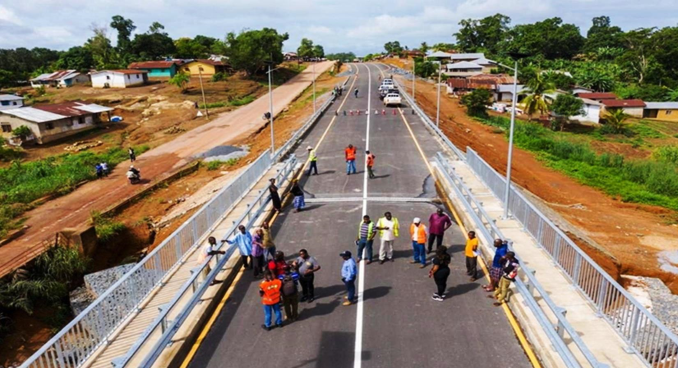By Cyril Barnes
FREETOWN, Aug 10 (232News) – On the cusp of Sierra Leone’s sustainable development pursuit, the New Direction administration has prioritized road construction as a driving force for sound economic growth and development. The primordial objectives of the government’s massive road construction drive are to use good road networks as a catalyst to fight poverty, link cities, towns and villages for agricultural and touristic productivities, provide access to employment and stimulate economic and social development, among others.
Roads are integral to any nation’s infrastructural development; they play a vital role in facilitating people, goods and services in the country. Given its significance, it is proven that improved road networks in Sierra Leone will foster better living standards by facilitating access to basic social services, boosting trade and economic integration of the West African region.
Sierra Leone’s economy heavily rests on the movement of people and commodities by road; however, the poor national road network poses a challenge. Knowing its importance and challenges, the New Direction administration has identified majors roads for construction and proposed a new strategic transport network to connect the mining belts in the Northeast and Southwest of Sierra Leone through the Southern Central farmland region. Under these plans, new roads would be centred on two “Economic Corridors” linking six “Regional Growth Hubs.” Intent upon this, there is an endless list of road projects that are being constructed, expanded and rehabilitated under the Bio administration.
The largest European Union-funded project in Sierra Leone is said to be the €105 million Bandajuma-Liberia Road and Bridges Rehabilitation Project. The project makes provision for upgrading 100km road between Sierra Leone and Liberia, including the construction of three new bridges crossing the Sewa, Wanjie and Moa Rivers. After completion, it is expected to boost Sierra Leone’s core road network and open the gateway to Liberia.
The African Development Bank believes the project will provide reliable access to socio-economic facilities, including schools, markets and health centres which, in turn, will boost the local economy and contribute to poverty alleviation. The road will also serve international traffic within ECOWAS/Mano River Union region (Liberia, Guinea and Sierra Leone), thus contributing to regional integration.
The €40.7 million Moyamba Junction-Moyamba Road project in the Southern province is predicted to greatly improve the road communication system between Moyamba Town and Masiaka-Bo Highway and provide easy access to the South-Eastern districts. It caters for the rehabilitation of a 33km road, including four bridges (Gbangbama River, Yambatui River, two-lane bridges over the Rokel River and the Ribi River). This major road is perceived to open the small mineral-endowed district to trade and investment opportunities.
Additionally, His Excellency Dr Julius Maada Bio, in November 2020, turned the sod for the construction of a major road network in the Goderich-Funkia community; the construction is expected to benefit over 30,000 people in the highlighted communities as well as boosting the country’s tourism sector. In his snappy delivery note, the President said his government had placed priority on the transport sector to improve people’s living standards and spur the nation’s economic growth.
“The rehabilitation of the Funkia-Goderich Road project is a fulfilment of the overall government strategy to open communities, towns and cities nationwide and facilitate the free-flow of goods and services, helping to improve the living standards of the people. Roads are part of the cornerstones of my government, and we shall continue to invest in the maintenance, rehabilitation and construction of more roads nationwide,” he affirmed enthusiastically.
Since President Julius Maada Bio commissioned the construction of Lumely-Juba Sengbe Pieh Bridge in 2019, several major and feeder roads have been constructed and rehabilitated, the Lumley Bypass Road linking Juba and Aberdeen Creek, the Limkokwing-Regent Ring Road have eased traffic congestion, expanded the city and created access for citizens and businesses.
Other ongoing road projects such as the Bonthe and Kenema Townships; 182km Bo-Mattru Jong Road linking Bo and Bonthe Districts respectively, the Songo-Moyamba Township Road, including Mabang Bridge, the Mano Junction-Bumpe Road linking Kenema and Kono District, the Kuwait-funded Lumley-Tokeh Road, linking Freetown and Western Rural and the Hill-Side Byepass Road have been dubbed as purposeful infrastructural developments projects.
In another development, SLRA has concluded the public disclosure on the environmental impact assessment of the 62.85km Kailahun-Koindu road that will be funded by the Africa Development Bank. The work is expected to start in September 2021. Before President Julius Maada Bio folds up his first term in office, it is envisioned that many major roads linking towns and villages will be constructed and rehabilitated.

